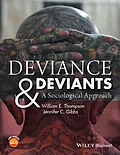This comprehensive and engaging textbook provides a fresh and sociologically-grounded examination of how deviance is constructed and defined and what it means to be classed a deviant.
* Covers an array of deviances, including sexual, physical, mental, and criminal, as well as deviances often overlooked in the literature, such as elite deviance, cyber-deviance, and deviant occupations
* Examines the popular notions and pseudoscientific explanations upon which the most pervasive myths surrounding deviance and deviants are founded
* Features an analytical through-line assessing the complex and multifaceted relationship between deviance and the media
* Enhanced with extensive pedagogical features, including a glossary of key terms, lists of specific learning outcomes in each chapter, and critical thinking questions designed to assess those outcomes
* Comprehensive instructor ancillaries include PowerPoint slides, a test bank for each chapter, instructor outlines, and sample activities and projects; a student study guide also is available
Autorentext
William E. Thompson is Professor of Sociology and Criminal Justice at Texas A&M University-Commerce. He is the co-author of Society in Focus: An Introduction to Sociology (with J. Hickey and M. Thompson, 8th edition, 2017) a leading introductory sociology textbook, and Juvenile Delinquency: A Sociological Approach (with J. Bynum, 10th edition, 2017) one of the foremost textbooks on delinquency studies. Professor Thompson has published more than forty articles in professional journals, including several that have been reprinted in textbooks and anthologies.
Jennifer C. Gibbs is Assistant Professor of Criminal Justice at Pennsylvania State University-Harrisburg. With articles published in several journals, including Crime, Law and Social Change, Police Practice and Research: An International Journal, and Violence Against Women, Dr. Gibbs is a member of the American Society of Criminology and the Academy of Criminal Justice Sciences.Klappentext
Often misconstrued as a synonym for depravity, deviance reflects more profoundly on the socially-constructed norms it is defined in opposition to than on the individual behaviors it is used to describe. This groundbreaking new textbook provides an engaging, sociologically-informed examination of how deviance is defined and what it means to be classed a deviant. Featuring an analytical through-line assessing the role of media in crafting and perpetuating definitions of deviance, the book examines an array of sexual, mental, and criminal deviances, as well as addressing those that are often overlooked, such as elite deviance, cyberdeviance, and deviant occupations. The authors interrogate pseudoscientific explanations for deviant behavior debunking many of the myths associated with deviance.
With questions to measure specific learning outcomes, a rolling glossary of key terms, and insights from people who have themselves been labeled as deviant, Deviance and Deviants will inform and enlighten students interested in better understanding the nuances of society's relationship with deviance.
Inhalt
Preface xiv
About the Companion Website xvi
1 Defining Social Deviance and Deviants 1
Student Learning Outcomes 1
What is Deviance? 2
The absolutist position 3
The statistical anomaly view 3
Box 1.1: In their own words: Being deviant: A lefthander in a righthanded world 4
The Sociological Perspective 7
The Social Construction of Deviance 7
Norms, social control, and a range of tolerance 8
Importance of culture, time, place, and situation 11
Importance of acts, actors, and audience 13
The Role of Media in Defining Deviance 15
Moral entrepreneurs, moral crusades, and moral panics 15
Confusing crime and deviance 16
Equating diversity with deviance 17
Negative and Positive Results of Deviance 17
Negative consequences of deviance 18
Positive aspects of deviance 19
Summary 20
Outcomes Assessment 20
Key Terms and Concepts 21
2 Deviance and Social Identity 22
Student Learning Outcomes 22
Becoming Deviant 23
Deviance as a Status 23
Deviance as a master status 24
Primary and secondary deviance 27
Box 2.1: In their own words: Primary deviance: Student cheating 28
Deviant career 29
Deviance as a Role 30
Roletaking, role embracement, role merger, and role engulfment 30
Role distance: The deviant deviant 32
Deviance, Deviants, and Stigma 32
Managing a Spoiled Identity 33
Deviance, Identity, and The Media 34
Summary 36
Outcomes Assessment 37
Key Terms and Concepts 37
3 Popular Notions and Pseudoscientific Explanations for Deviance 38
Student Learning Outcomes 38
Demonology: The Devil Made Me Do It 39
Box 3.1: In their own words: Interview with a twentyyearold wiccan 41
Morality, Immorality, and Deviance 42
Positivism, Pseudoscience, and the Medical Model of Deviance 44
Early biological and physiological theories of deviance 44
The medical model of deviance 48
The medicalization of deviance 49
Blame it on the Media 50
Print media and deviance 50
Television, movies, video games and deviance 52
Media violence, aggression, and deviant behavior 53
The internet and the power of social media 54
Fallacies of Popular Notions and Pseudoscientific Explanations 55
Summary 56
Outcomes Assessment 56
Key Terms and Concepts 57
4 Sociological Explanations for Deviance 58
Student Learning Outcomes 58
A Functionalist Perspective on Deviance 59
Strain theories 60
Deviant subcultures 63
Strengths and weaknesses of the functionalist perspective 65
The Conflict Perspective and Deviant Behavior 66
The Marxian heritage 66
The social reality of crime and delinquency 67
Social threat theory 68
Strengths and weaknesses of the conflict perspective 68
Interactionist Theories and the Constructionist View of Deviance 69
Labeling theories 71
Social learning theories 73
Control theories 75
Strengths and weaknesses of interactionist theories 76
A Feminist Perspective on Deviance 77
The Pervasive Influence of the Media 78
Box 4.1: In their own words: By Noah Nelson 79
Summary 80
Outcomes Assessment 81
Key Terms and Concepts 81
5 Deviant Occupations 82
Student Learning Outcomes 82
The Sociology of Work 83
Occupation as Master Status 84
Illegal Occupations 86
Immoral Occupations: Working in the Adult Entertainment Industry 87
Working in adult films 88
Stripping/nude dancing 90
Box 5.1: In their own words: ...
